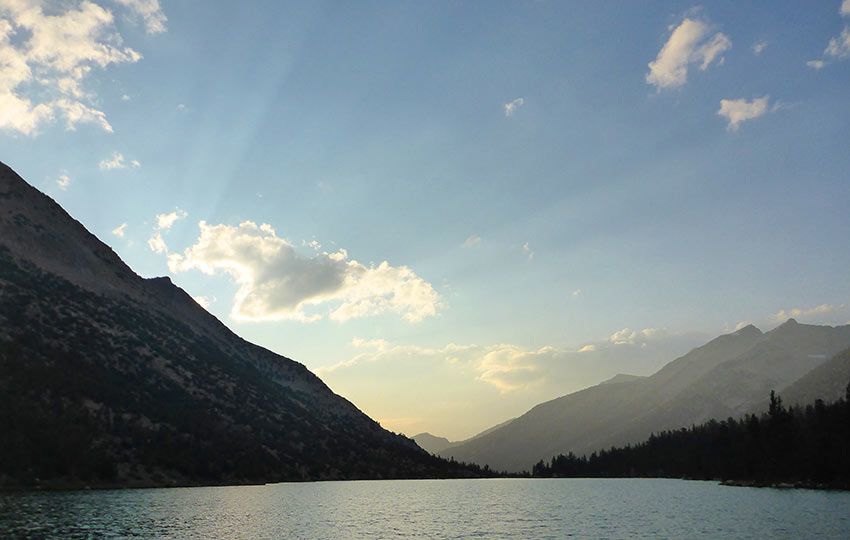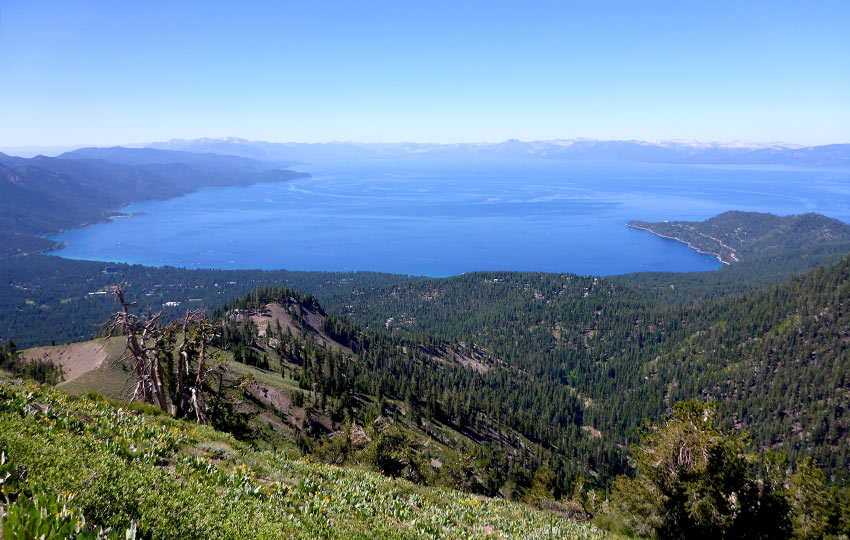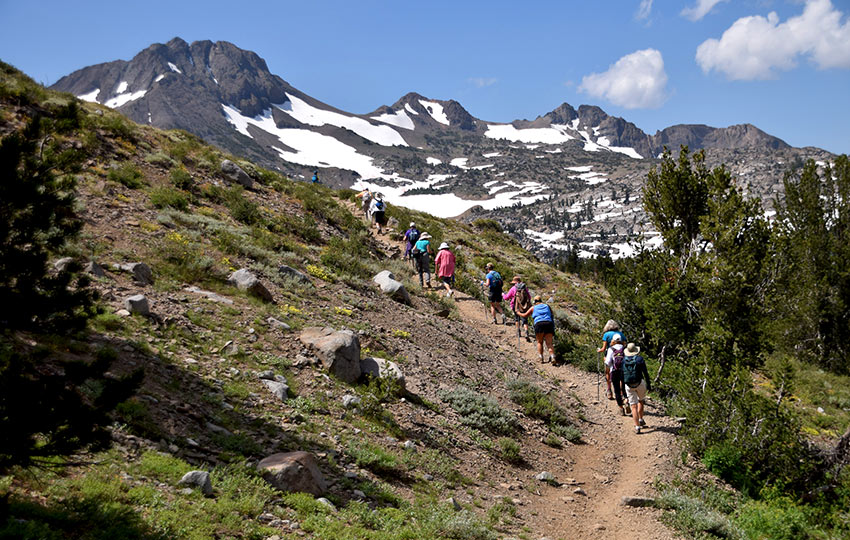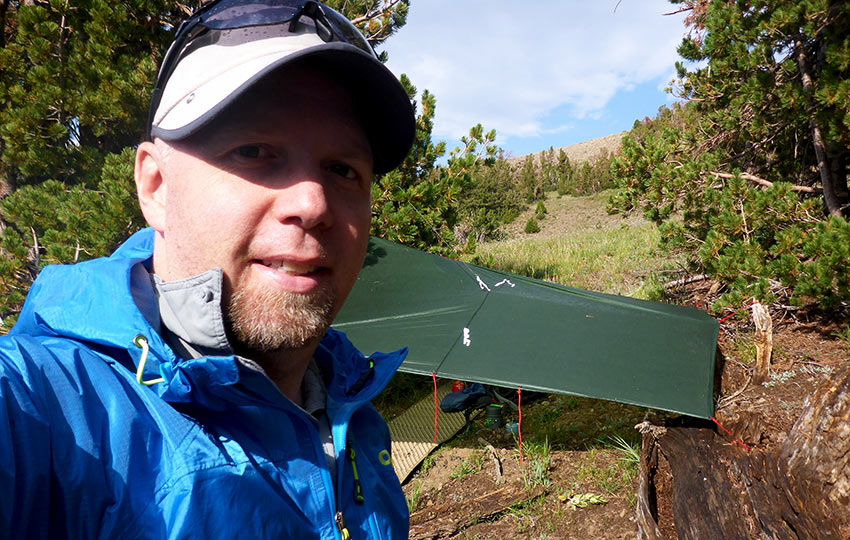
Whether you’re planning a day-long excursion to one of Lake Tahoe’s fabled mountain peaks or a multi-day expedition into Desolation Wilderness, there are many considerations to take into account when preparing for your backcountry trip. However, the single most important element to establish during the planning phase is the purpose or goal of your backcountry trip.
“What do you mean I need to have a purpose behind my backpacking trip?” you ask. “That’s why I go backpacking. To stop thinking. To decompress. I just wanna hike up to Star Lake and camp out for the night to get my mind off of work.”
Well, there you have it. You just established a purpose.
Support Tahoe Trail Guide with a financial contribution via PayPal (single contribution) or Patreon (reoccurring contributions). Your support of Tahoe Trail Guide is very much appreciated!

It really can be that easy. But even if you’re just going on a short overnight backpacking trip to unwind, actually declaring that purpose, choosing that goal, setting that intention, establishing that mission statement (call it what you will) yields many benefits and contributes to your success and safety.
By establishing a goal for your backcountry trip, in essence, you create a framework for your trip that:
- informs all aspects of your backcountry trip from gear selection to route planning to the creation of contingency measures.
- clarifies expectations among everyone in your group (even when it’s just you) and the people who will be providing support.
- acts as a metaphorical compass by which you can refer to when in doubt about whether or not you are on the correct path and/or to confirm when you are heading in the right direction.
To be clear, I’m not advocating that you turn a relaxing overnight backpacking trip to Watson Lake into a military campaign. I’m not saying that every aspect of your trip should be laboriously detailed, scrutinized, and written down on a checklist. Then, laminated so that each phase of the operation upon completion can be crossed off with a grease pencil.
Just know that, even though most of us traveling in the backcountry have similar goals, we’re all unique and our goals will reflect those differences.
1) A Goal for Your Backcountry Trip Informs All Aspects of Your Trip

Some people want to camp at Round Lake and spend the day swimming, sun bathing, and relaxing with their friends. Those folks will probably pack more creature comforts since they’ll be spending more time in a sedentary environment. They can afford to carry more weight since they’ll only be hiking a few miles to their campsite.
Their emergency plan might be to leave everything behind but their wallets and car keys. Then, they could just run the five miles back to their vehicle. I would never recommend leaving anything in the backcountry. However, this is an option (albeit a poor one) due to the location’s relatively close proximity to the trailhead.
Those backpackers are also likely to meet other hikers who could potentially provide help. This is because the trail to Round Lake is a favorite among day hikers.
On the other hand, some people enjoy covering bigger miles and climbing more elevation in order to sleep under the stars on top of, say, Freel Peak.
That person will pack lighter, carry only the essentials, and have identified multiple evacuation routes prior to starting their trip.
There are many other unique reasons people backpack at Lake Tahoe. Maybe they’re providing a resupply to a Tahoe Rim Trail thru-hiker or want to photograph the sun rising from Maggie’s Peak. Or, they want to develop confidence and exercise independence by backpacking alone in Desolation Wilderness for a few days.
No matter your goal, the more specific you are about it the more you can begin to ask (and answer) the relevant questions about your backcountry trip.
2) A Goal for Your Backcountry Trip Clarifies Expectations

Even for day hikes I try to be as clear as possible about my intentions for the hike.
If my goal is to search for and photograph Sierra Nevada wildflowers, for example, I’ll only schedule a few miles of hiking. I’ll be moving at a snail’s pace so there’s no point in trying to hike far.
But if I’ll be hiking with another person and their intention is to get in a good workout, there’ll probably be friction between us. This will be due to our opposing goals.
In order to avoid this frustrating scenario, I’ll clarify both of our expectations for the day.
This is a pretty simplified example, I realize. However, similar situations always happen to friends and family while on vacation. Whenever you have more than one person to consider, you have the potential for conflicting goals and expectations.
Problems are magnified in the backcountry. So, consider instead of only having a few miles of well-established trail to cover, you and your partner get caught in a lightning storm on top of an exposed mountain. And then you discover, after the fact, that your friend had only wanted to snap a few pictures of wildflowers that day.
If conforming my goals to my partner’s means we’re going to have a better (and safer) experience, I will do it.
Just as important is to let your support crew know what the goal is for your backcountry trip. Then, inform them about your travel and contingency plans. They should also know your experience and abilities.
Keep in mind that your support crew might only consist of the one person. Regardless, share your itinerary with them prior to leaving for your trip.
In September 2017, I delivered a food resupply via Kearsarge Pass (southern Sierra Nevada Mountains) to a friend who was thru-hiking the John Muir Trail.
The plan was for me to meet her at Charlotte Lake and camp together overnight. In the morning, I would hike back to my Jeep that was parked at Onion Valley Campground and she would continue north along the JMT. My friend elected to hike the John Muir Trail northbound, so the resupply was to take place on the fourth and fifth day of her trip.
I have traveled this section of the JMT before, so I knew the area well. However, leading up to her departure (from home and to the trail) we had only been communicating via text and Facebook messages. We never had a full conversation detailing the logistics of our plan, like where we would specifically meet at Charlotte Lake, how we would identify each other if either of us arrived after dark, or what we would do in the off-chance that we never met at all.
I have no explanation for why we allowed this major oversight in planning to occur other than we were both busy with hectic work schedules at the time. Strangely enough, I didn’t think this was an issue until I was hiking the final mile down to Charlotte Lake. The sun was setting, and I began to realize that maybe our simple plan wasn’t so infallible.
My friend never made it to Charlotte Lake that night, and I spent most of the evening trying to quell the panic I felt rising within me.
I have thru-hiked the Appalachian Trail and the Tahoe Rim Trail, so I know that part of the thru-hiking experience is occasionally missing your day’s mark. My friend has also thru-hiked the Tahoe Rim Trail and was now beginning to thru-hike the more challenging John Muir Trail.
I re-checked my copy of her itinerary and determined that the most likely cause of her absence was that she was exhausted from hiking up and over Forester Pass that day. She probably decided to stop short and camp at Vidette Meadow that night, then make up those missed miles early the next morning. This is what I would’ve done.
Yes, there were a million other scenarios I considered (and ultimately dismissed) that evening. The reason being was that her goal was the thru-hike (not a section or a weekend on the JMT). She was in it for the long haul and, as such, the routine when thru-hiking is to pace yourself at the beginning so your body can adjust to the miles and terrain.
The next morning I decided to slowly break down camp in order to give my friend some time to catch up. By 7:45am, I was back on the trail and that’s when I saw my friend hiking toward me. My theory was her reality. I delivered the resupply, we chatted for a while, and then she continued hiking. About two and a half weeks later she completed the John Muir Trail.
3) A Goal for Your Backcountry Trip Acts as a Metaphorical Compass
Unless the weather is terrible, you forget a critical piece of gear, or you have a freak accident, it’s pretty hard to have a bad experience on a single overnight backcountry trip. So in this situation having a goal in mind (to use as a litmus test for your experience) is not as important as if you were preparing for a more complex outdoor excursion.
It’s kind of like collecting data to test a theory. One day’s worth of data is usually not enough to support or disprove the theory.
I still believe for short trips, however, that it’s in your best interest to identify a goal if only for the first two reasons I mentioned in this article (helps to dial in the logistics of your trip and clarifies your expectations).
If you’re planning a longer backcountry trip, though, such as thru-hiking the John Muir Trail or Pacific Crest Trail you need to have your mind right (at least most of the time).
What I mean by this is that you need to be crystal clear as to why you’re hiking such a long distance because these types of trails can be soul crushers if you’re not mentally prepared for them.
There’s a reason that the three trails that make up the “triple crown” of backpacking (Appalachian Trail, Pacific Crest Trail, and Continental Divide Trail) have an average success rate of about 25%.
They break people.
Many failed attempts are due to physical reasons such as injuries. However, most often they’re due to a lack in mental preparation.
Having that specific goal won’t guarantee your success, but at least you have a place in which to mentally return and refocus when things get tough.
Being frustrated and wavering once in a while in pursuit of a long-term goal is typical. But those moments of hesitation need to be short-lived and occasional at most.
Longer backcountry trips provide you so many more opportunities for failure. So, unless you’re goal is clear and precise, the whole process has the potential of being one long, miserable experience.
Nothing in the backcountry is easy. The last thing you want to be doing is dillydallying and second-guessing yourself while inclement weather is looming overhead and you still have miles to travel.
Also with those longer trips, you should occasionally refer to your original goal to determine whether or not it’s relevant anymore. Many people choose to layer their goals with additional goals such as hiking the trail and raising money or awareness for a cause, stopping to paint a picture each day, or collecting all the trash they find on the trail.
Those are all worthwhile pursuits, but you need to monitor your operation to determine if achieving the primary goal is being overridden by a secondary or tertiary goal.
Lastly, you can refer back to your original goal (along with your plans and preparations) during the post-trip analysis.
Some questions you may want to ask yourself are:
- Did you achieve your goal?
- Did you achieve your goal too easily?
- Was your goal too challenging and, if so, how could you re-frame it?
- Did your goal change during your experience?
Analyzing your goal after the experience should aid you with planning your future backcountry trips.

I agree that all of this borderlines on being too cerebral and over-the-top, but traveling in the backcountry (even for just a day) should not be something you take lightly.
Years ago when I served in the US Marine Corps, someone always mentioned the adage proper prior planning prevents piss poor performance whenever it looked like we were becoming complacent with our training preparations.
In the backcountry, catastrophe manifests in many forms. And, although you can’t plan for everything, you should endeavor to be as prepared as possible.
Having a plan, goal, or purpose for your backcountry trip is your first step in the right direction.
Planning Your Backcountry Trip Core Series of Articles:
- The Importance of Establishing a Goal for Your Backcountry Trip
- SMART Goals and Your Backcountry Trip
- The Decision-Making Process and Your Backcountry Trip
- Gathering Information for Your Backcountry Trip
- Evaluating Information and Choosing the Best Option for Your Backcountry Trip
- Planning and Preparing for Your Backcountry Trip
- Executing Your Backcountry Trip Plan
- Returning Home and Post-Backcountry Trip Analysis

After reading this article a friend told me (I’m paraphrasing here), “But sometimes I just like to go on a hike without any plans and let nature surprise me.” I agreed that I, too, like to do that on occasion. However, I still argue that this constitutes a “goal.” It might not be a very active goal, but it’s a goal or a plan nonetheless. The decision to do nothing, for example, is still a decision. And, doing nothing is still doing something. You’re simply doing nothing. Without getting heavy into the philosophy of meditation and all the zen stuff about emptying your mind, surrendering to the universe, etc. … know that if you’re waiting around for something to happen, your still doing something. You are waiting.
Chess masters don’t actually plan 20 moves in advance. They develop their pieces (make decisions) with the intention of creating a favorable environment from which success will (hopefully) occur. What I’m ultimately trying to convey here is that our lives are not random. They are the result of the series of choices and decision (goals) we make throughout life. This is not to say that the resulting consequences of our decisions are always commensurate because there is that whole deal about being in the wrong place at the wrong time. You simply can’t plan for every emergency or predict every catastrophe. However, if you act like a chess master and make conscious decisions (goals) that you believe will lead to favorable outcomes, I believe you will have the greatest opportunity for success. I also believe that going into the backcountry comes with its own additional set of risks, and in order to mitigate some of those risks it’s imperative to have a goal or plan established before you even set foot on the trail. Be mindful and own the choices you make in life.